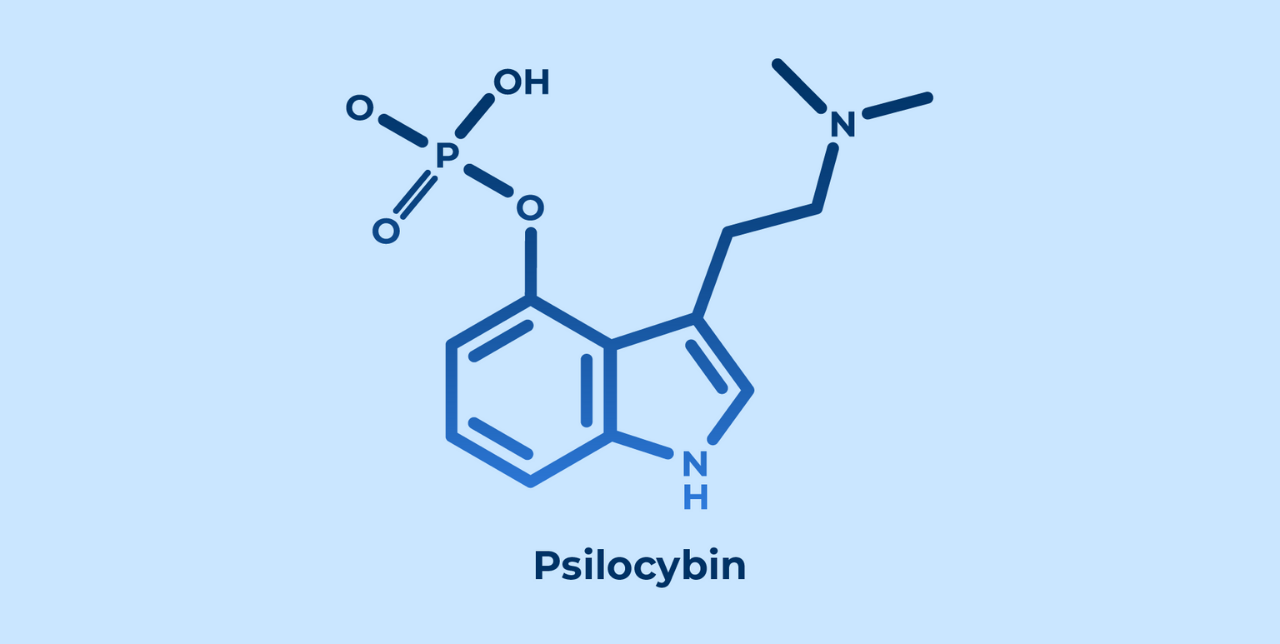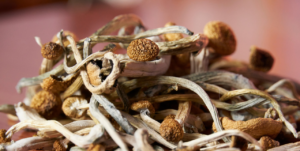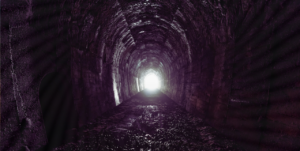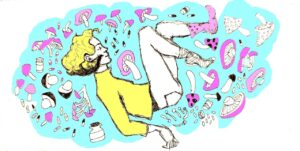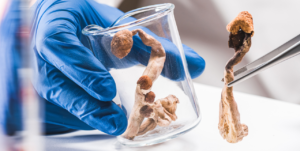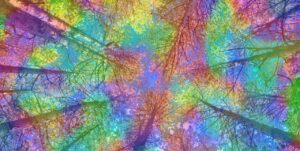We’ve all heard the term ‘magic mushrooms’ – unless perhaps you’ve been living under a rock. Even then, once you poke your head out from that rock, you’ll find a mushroom growing nearby. That’s because fungi are found everywhere on earth and play a key role in decomposition – one of the most important processes for maintaining life on the planet. But what makes a “magic mushroom” so magic? A lot, as it turns out! Read on to learn more about these fascinating organisms and why you may just want to try them yourself.
A brief history of mushrooms.
It would be remiss not to mention the origin story of fungi when talking about psilocybin, the active compound in magic mushrooms; it’s actually our origin story too. Fungi were the first terrestrial organism, with recent fossil evidence showing their presence roughly one billion years ago – that’s 600 million years before the first animals ventured onto land! They kickstarted the rotting process allowing for a layer of fertile soil to slowly form, further enabling plants with root systems to develop and, in turn, animals.
What’s possibly more surprising is that we share a common ancestor with fungi. According to evolutionary microbiologist Mitchell Sogin, who discovered the connection in 2004,”There was a single ancestral group of organisms, and some split off to become fungi and some split off to become animals.” The latter becoming us.
When it comes to psilocybin, its usage within human society predates civilization’s birth, around 6000 years ago – and potentially hundreds of thousands of years earlier. Rock carvings from Northern Australia depicting mushroom symbolism have been dated to approximately 10,000 B.C.E. While this is the oldest hard evidence we have, it’s theorized that psilocybin has played an essential role in the development of our evolution. Initially proposed by famous ethnobotanist and psychonaut Terrance McKenna, the Stoned Ape Theory (which is more correctly a hypothesis) suggests that the use of psychedelics was, in part, responsible for the doubling of the human brain some 200,000 years ago.

So what happened? Why is there now such a stigma surrounding these ancient teachers?
It started with an international treaty developed by the United Nations in 1971 – The Convention on Psychotropic Substances. The aim was to prohibit the production, consumption, and distribution of psychedelic substances, including psilocybin, and since the 1970s, more than 180 countries have signed.
The Controlled Substances Act came into force the same year in the United States. The passage of this act helped launch the notoriously unsuccessful “War on Drugs”, and classified magic mushrooms plus other psychedelics as Schedule I drugs. Schedule I drugs are defined by the Drug Enforcement Administration (DEA) as ‘drugs with no currently accepted medical use and a high potential for abuse’. Of course, that statement completely contradicts the scientific research done in the 1950s and 1960s, when the potential of psychadelics for helping treat mood disorders and alcoholism was being discovered.
What is psilocybin exactly?
Psilocybin comes from “magic mushrooms.” More than 200 mushrooms species around the world produce the psilocybin that humans ingest. Psilocybin is a prodrug, a compound that, when metabolized by the body, is converted to psilocin—a psychoactive chemical.
Both psilocybin and psilocin are chemicals called tryptamines. Tryptamines have chemical structures that are very similar to serotonin, an important neurochemical. Due to psilocin’s similarity to serotonin, it can bind to the same receptors in the brain that serotonin binds to. When psilocin binds to and activates serotonin receptor sites— like the 5-HT2A receptor—that’s when you start to feel psychedelic effects.
Although the science is limited so far, recent studies show that psilocybin also works by suppressing the parts of the brain responsible for filtering information out from your senses. This “sensory overload” is thought to be partially responsible for some of the psychadelic effects people experience from psilocybin.
Before you trip: Consider set and setting
If you’ve done any research on magic mushrooms, you’ve probably heard of the importance of set and setting. It can’t be stressed enough how important these are for an enjoyable trip, especially for your first experience.
- Set refers to the mindset you are in when taking the mushrooms, such as your mood, thoughts, and expectations. If you’re anxious, stressed, or fearful, the likelihood of having a bad trip significantly increases. A trip is better if you’re in good place mentally.
- Setting refers to the physical environment in which you take the mushrooms—the location, the weather, the people around you etc… You want to be in an environment where you feel safe. You should be in good company too, people you feel very comfortable around. If you start to have a bad trip, the people around you can help bring calmness and reassurance. For your first trip, it could be wise to have a “trip sitter,” someone sober nearby, so you have someone to help you in the event of a bad trip or injury.
With a good set and setting you’re off to the races. After taking psilocybin, you’ll feel a sensation of euphoria and peace washing over you. Depending on the dose you take, you may experience varying degrees of hallucinations, including warping and ‘breathing’ objects, enhanced colors, patterns, and geometry. It’s common to feel a sense of connectedness with the people around you, your inner self, and the natural world. You may also lose your ego, or sense of self, at higher doses, seemingly becoming one with consciousness itself. For many, these experiences have profoundly positive effects on mental health and self-awareness, benefits that last long after the trip.
Some mushroom trips can involve negative experiences from time to time. Although often short-lived, you may experience some nausea or discomfort in your stomach shortly after you’ve ingested your shrooms. A bad trip can be a frightening and potentially dangerous experience, so it is important to consider your set and setting before starting your shroom trip. It’s generally ill-advised to take mushrooms in a chaotic environment, such as a party or rave, unless you’re very experienced and have someone to look out for you.
Some luxury retreats are even designed around the magic mushroom experience.
Psilocybin; past, present and future
While taking mushrooms recreationally can be a fun, enlightening experience, modern research shows there are tremendous potential therapeutic applications for psilocybin as well.
As mentioned earlier, humans have been using psychedelics for millennia. Many indigenous peoples around the globe still practice ancient healing and spiritual arts as they did hundreds of years ago. Mayans and Aztecs, for example, used magic mushrooms as part of their spiritual ceremonies – to heal and commune with the divine.
Today, studies are being conducted to evaluate the safety of psychedelics, including psilocybin, for the treatment of depression, anxiety, substance addiction, obsessive-compulsive disorder, and cluster headaches. As medical science and research around psilocybin evolves, we’re likely to hear more about this exciting natural substance in the future.
The Mushrooms Drug: 5 Scary Myths About Shrooms Get Debunked
People have been using psilocybin for thousands of years for religious and spiritual reasons, recreation and more. But in the last 100 years “magic mushrooms” […]
Read MoreMagic Mushrooms: How Often? Dosage and Frequency
Magic mushrooms, or psilocybin mushrooms, have gained a lot of attention recently for their potential therapeutic benefits. From enhancing creativity to managing depression, the reasons […]
Read MoreMushroom Bad Trip: Immediate Actions and Prevention Tips
Venturing into the world of psychedelic mushrooms can be an enlightening experience, but it’s not without its risks. One of these is the dreaded mushroom […]
Read MorePsychedelic Mushrooms: 10 Amazing Benefits
Psychedelic mushrooms aren’t just for tripping anymore. Researchers are garnering evidence that medical psilocybin may help deliver a surprising number of benefits; from boosting creativity, […]
Read MoreAnatomy of Psilocybin Mushrooms: Beyond the Cap
Psilocybin mushrooms, often hailed for their psychedelic effects, hide a world of complexity beneath their often modest exteriors. Understanding the anatomy of psilocybin mushrooms not […]
Read MoreMagic Mushroom Trip: 5 Essential Tips to Prepare
5 Essential Tips to Prepare for Your Magic Mushroom Trip Diving into the world of magic mushrooms can be transformative, but like any profound experience, […]
Read More